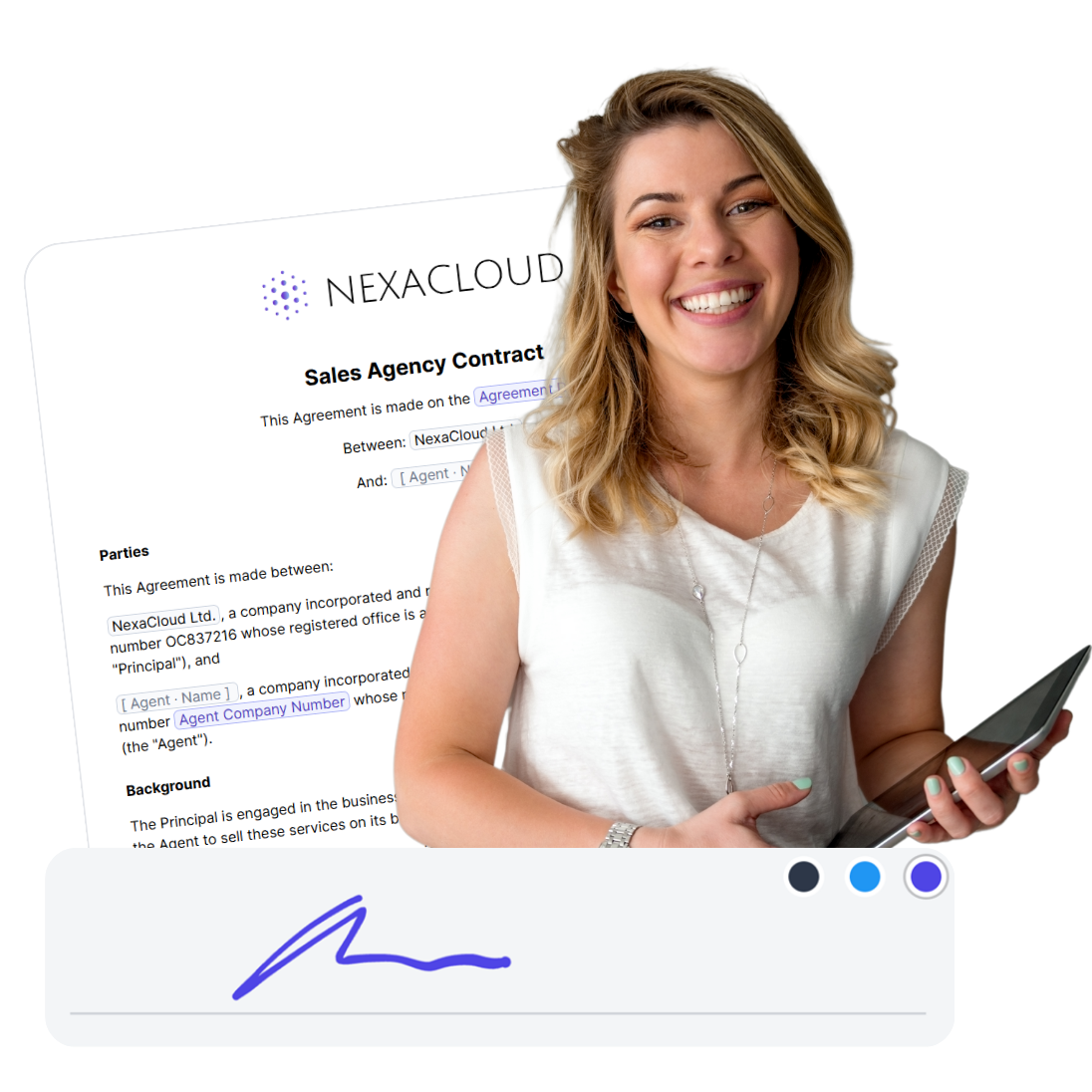How Contracts Are Usually Signed
Contracts are usually signed either physically (handwritten) or electronically, by all involved parties to confirm their agreement to the terms. Each party typically signs on designated signature lines, along with the date of signing. In this article, we cover both methods and see how modern businesses leverage technology to streamline the contract signing process, ensuring efficiency, security, and compliance with legal standards.

Imagine it’s a busy day, and you’ve just nailed down the final details of a big deal. Now, all that’s left is the signing. Back in the day, this meant printing out the contract, signing your name with a pen, scanning it, and then emailing it back—or maybe even mailing it if you’re really old-school. This dance was part of every deal, big or small.
This method is the crossword enthusiasts’ favorite five-letter answer: ININK!
But here’s the twist: while many still tread this familiar path, a wave of change has been sweeping across the business world. The realization has dawned that maybe, just maybe, there’s a better way. Because let’s face it, the traditional pen and paper method isn’t just slow; it’s also prone to mistakes and, worse, tampering.

Enter the hero of our story: the electronic signature. This modern marvel allows you to seal the deal with a simple click. No printing, no scanning, just a straightforward digital thumbs-up that sends the signed document zipping through the digital ether to everyone who needs it. And the best part? It’s not just for the big players. Small businesses are finding that this swift, secure method of signing off on agreements saves time, cuts costs, and lets them keep pace with the fast-moving digital world.
The Legal Basis of Contract Signing
A contract, in its simplest form, is a mutual agreement with the power of law behind it. For an agreement to hold up legally, it must have a clear offer, acceptance, and exchange of value. Though the method of signing may differ—from ink signatures to digital ones—key legislations like the UETA and E-SIGN Act in the U.S., and eIDAS in the EU, ensure that electronic and digital signatures are just as legally binding as traditional ones. This legal backing empowers businesses to embrace digital methods confidently.
International agreements for contract signing
In the United States, the Uniform Electronic Transactions Act (UETA) and the Electronic Signatures in Global and National Commerce Act (E-SIGN Act) have established a legal framework that recognizes electronic signatures as equivalent to handwritten signatures. Similarly, the European Union’s eIDAS regulation provides a standardized rule set for electronic identification and trust services, including electronic signatures, across EU member states. These laws affirm that, if all parties agree to use electronic signatures, the signed contract is just as legally binding as one signed with ink on paper.
Digital Signature Technologies
Digital signatures represent a sophisticated form of electronic signature. They utilize encryption to ensure the security of electronic documents and verify the signer’s identity. Unlike a simple electronic signature, which might be as basic as typing a name into a contract or pasting a digital image of a handwritten signature, digital signatures are secured with digital certificates. These certificates provide a means of authenticating the identity of the parties involved and ensuring that the document hasn’t been tampered with after signing.
The key difference between electronic and digital signatures lies in their level of security and authentication. Digital signatures come with a unique identifier that is securely linked to the signer and uses encryption to prevent tampering. This makes digital signatures particularly valuable for legal documents and contracts, where security and verifiability are paramount.
As businesses continue to embrace digital transformation, the adoption of digital signature technologies has surged. These technologies not only simplify the contract signing process but also add layers of security and efficiency that traditional methods cannot match. For companies leveraging contract management SaaS platforms, digital signatures offer a seamless way to expedite agreements without compromising on legality or safety.
By understanding these foundational elements, businesses can better navigate the legal and technical landscapes of digital contract signing. This knowledge serves as a stepping stone towards adopting more efficient, secure, and modern contract management practices.
Streamlining Contract Signing with SaaS
Contract Management Software as a Service (SaaS) platforms are revolutionizing contract handling by automating and digitizing the entire process. These platforms not only save time by eliminating manual tasks like drafting and sending reminders but also enhance security with centralized, encrypted storage for all contracts. The ability to manage the entire lifecycle of a contract—from creation to signature and beyond—on a single platform streamlines operations and reduces the chance of errors, making contract management a smooth, seamless process.
By adopting a contract management SaaS, businesses can enjoy a multitude of benefits:
- Efficiency: Automate routine tasks, such as generating contracts from templates and sending reminders for reviews or signatures, thus speeding up the contract lifecycle.
- Centralization: Store all contracts in a single, secure digital repository, making it easier to search, access, and manage agreements.
- Compliance: Track changes and maintain detailed logs of contract modifications and signings, ensuring compliance with relevant laws and regulations.
- Security: Advanced encryption and secure access controls protect sensitive information from unauthorized access.
This streamlined approach not only reduces the time and resources spent on contract management but also minimizes human error, ensuring that contracts are executed correctly and efficiently.
The Process of Digital Contract Signing
The digital contract signing process within a SaaS platform is straightforward and secure, designed to ensure that all parties can review, approve, and sign documents with ease. Here’s a typical workflow:
- Document Preparation and Upload: The contract is created, often using customizable templates provided by the platform. Once finalized, it’s uploaded to the platform if it wasn’t already created on it.
- Review and Approval Workflow: The contract is sent to relevant parties for review. The platform can track changes, facilitate discussions, and ensure that all necessary approvals are obtained before moving forward.
- Signing the Document: Parties are notified when it’s their turn to sign. Using digital signatures, they can sign the document from anywhere, on any device. The platform ensures the security and legality of these signatures.
- Post-signature Management: After signing, the contract is automatically stored in the platform’s secure digital repository. It can be accessed at any time, with full audit trails available to track access and changes.
This process not only simplifies the act of signing contracts but also ensures that each step is compliant, secure, and efficiently managed.
fynk: Comprehensive Contract Signing Solution
fynk simplifies the contract signing journey, offering a seamless suite of tools for generating enforceable digital signatures and crafting written agreements with ease.
As soon as a signatory gives their nod of approval, fnk promptly produces a signed version of the contract complete with a timestamped certificate, all of which is securely stored online for easy access.
In addition, fynk holds your rich collection of contract templates to streamline your document creation process, removing the complexity from drafting new agreements.
For business owners or sales team members responsible for drafting, dispatching, and signing contracts, turning to an integrated software solution like fynk could be the strategic move you need.
Searching for a contract management solution?
Find out how fynk can help you close deals faster and simplify your eSigning process – request a demo to see it in action.
Best Practices for Digital Contract Management
To fully benefit from digital contract management and signing, businesses should follow best practices that ensure the legality and security of their agreements:
- Legal Compliance: Stay informed about the legal standards and requirements for digital signatures in your jurisdiction. Ensure your SaaS platform complies with these standards.
- Verify Signer Identity: Use platforms that provide robust authentication methods to verify the identity of each signer. This may include multi-factor authentication, digital certificates, or other secure identification processes.
- Secure Storage: Choose a platform that offers encrypted storage for your contracts. This protects sensitive information from unauthorized access and ensures data integrity.
- Audit Trails: Maintain comprehensive audit trails for all contracts. This includes tracking who accessed the document, what changes were made, and when each action occurred.
- Regular Updates and Training: Technology and legal requirements can change. Regularly update your software and train your team on best practices for digital contract management.
By adhering to these best practices, businesses can maximize the benefits of digital contract management, ensuring their contracts are not only efficient and easy to manage but also secure and legally binding. This proactive approach to contract management can save time, reduce costs, and enhance overall business operations.
Future Trends in Contract Signing
The future of contract signing is poised for significant technological advancements that promise to further streamline the process and integrate more sophisticated security measures. Here are some trends likely to shape the future of contract management and digital signing:
- Blockchain and Smart Contracts: Blockchain technology is set to revolutionize how contracts are signed, stored, and verified. Smart contracts, self-executing contracts with the terms of the agreement directly written into code, automate and secure the contract execution process. This technology ensures unparalleled security, transparency, and efficiency.
- Artificial Intelligence (AI) and Machine Learning: AI and machine learning are transforming contract management by automating routine tasks, such as drafting contracts based on pre-defined templates and analyzing contracts for compliance and risk. These technologies can predict outcomes based on past contract performance, offering valuable insights for future negotiations.
- Increased Mobile Accessibility: As remote work becomes more prevalent, mobile access to contract signing and management will become a necessity. Future platforms will likely offer more robust mobile applications that provide the full suite of desktop features, allowing users to manage contracts anytime, anywhere.
- Enhanced Security Measures: With the rise of cyber threats, security will remain a top priority. Future digital signature solutions may incorporate advanced biometric verification methods, such as fingerprint or facial recognition, to authenticate signers with even greater accuracy.
- Global Standardization: As businesses continue to operate on a global scale, there will be a push towards standardizing digital signature laws and regulations across borders. This will facilitate smoother international transactions and contract signings.
Conclusion
The evolution of contract signing from paper-based to digital methods marks a significant leap forward in how businesses execute and manage agreements. By embracing digital contract management and signature technologies, companies can achieve greater efficiency, security, and compliance. The integration of advanced technologies like blockchain, AI, and enhanced mobile capabilities promise to further revolutionize this space, making contract signing more accessible, reliable, and secure than ever before.
As we look to the future, it’s clear that the adoption of these digital solutions will become not just an option but a necessity for businesses seeking to remain competitive and agile in an increasingly digital world. By staying informed about legal requirements, adopting best practices, and keeping an eye on emerging technologies, businesses can navigate the evolving landscape of contract management and digital signatures with confidence.
References and Further Reading
To delve deeper into the topics covered in this article, consider exploring the following resources:
- The Uniform Electronic Transactions Act (UETA) and the Electronic Signatures in Global and National Commerce Act (E-SIGN Act) for understanding the legal framework in the United States.
- The eIDAS regulation for insights into electronic identification and trust services in the European Union.
Please keep in mind that none of the content on our blog should be considered legal advice. We understand the complexities and nuances of legal matters, and as much as we strive to ensure our information is accurate and useful, it cannot replace the personalized advice of a qualified legal professional.

Table of contents
Want product news and updates? Sign up for our newsletter.
Other posts in Contract-Management

How to Review Business Contracts Like a Pro in 2025
When it comes to business contracts, what you don’t catch can hurt you. That’s why reviewing a business …

10 Best Contract Lifecycle Management Practices in 2025
Remember when closing a deal meant printing five copies, couriering them for “wet” signatures, then hunting …

How to Write a Contract Proposal (+Examples)
Imagine a freelance marketing consultant gearing up to pitch their services to a mid-sized tech company. …
Contracts can be enjoyable. Get started with fynk today.
Companies using fynk's contract management software get work done faster than ever before. Ready to give valuable time back to your team?
Schedule demo

